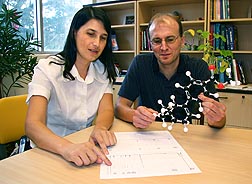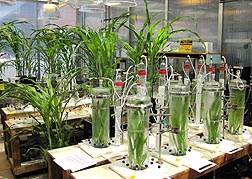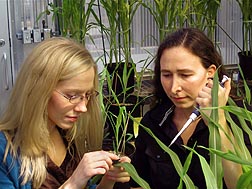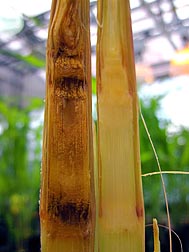Corn Defenses Probed for New Pest Fighting Clues
A clearer picture of corn’s biochemical responses to insect and fungal attacks is emerging, thanks to new findings by Agricultural Research Service scientists in Gainesville, Florida.
On one front, a team led by ARS plant physiologists Eric Schmelz and Alisa Huffaker has identified 10 compounds in corn, kauralexins and zealexins, which rapidly accumulate at fungal infection sites, impeding the microbes’ spread. Kauralexins and zealexins, members of a larger family of plant-defense compounds known as “terpenoid phytoalexins,” are also partly triggered by insect chewing—with Ostrinia nubilalis, the European corn borer, among species that find them distasteful.
On another front, Huffaker led the discovery of a new peptide (protein) in corn, ZmPep1, that’s produced in response to fungal infection. In addition to serving as a sort of “call to arms,” the peptide helps the plant mount a timely counter-offense.
“This is the first time a peptide signal has been shown to turn on biochemical defenses in maize,” notes Schmelz, who along with Huffaker published a paper on ZmPep1 in the March 2011 issue of Plant Physiology.
Huffaker, Schmelz, and seven coauthors from ARS and the University of Florida (UF) reported their kauralexin and zealexin findings in the March 2011 issue of Proceedings of the National Academy of Sciences and the August 2011 issue of Plant Physiology.
Taken together, the discoveries add significantly to the existing body of knowledge on corn’s stress-coping mechanisms and set the stage for novel approaches to improving its insect and disease resistance.
Entomologist Xinzhi Ni, who collaborated with the teams led by Huffaker and Schmelz, is optimistic that new indices derived from the terpenoid phytoalexin studies will prove useful to a corn-breeding program under way at ARS’s Crop Genetics and Breeding Research Unit in Tifton, Georgia. “We are going to examine the roles of these compounds in developing insect- and disease-resistant corn germplasm,” says Ni. “This collaborative research is a good example of the synergy between basic and applied research,” he adds.
Zealexins and kauralexins are nonvolatile, yet both are derived from volatile organic compound precursors, namely sesquiterpenes and diterpenes, which have been widely studied in plants, including such crops as cotton, beans, and rice. Many scientists have focused on the production and function of terpene volatiles in response to insect leaf-feeding—“not what happens when an insect bores into the stem of a corn plant,” says Schmelz.
Analyses of these previously unknown defense mechanisms were significantly aided by the efforts of ARS postdoctoral researchers Nicole Dafoe and Martha Vaughan, who are in the Chemistry Research Unit at ARS’s Center for Medical, Agricultural, and Veterinary Entomology in Gainesville.
|
|
Borer Bullies
By examining the stalk’s genetic and biochemical responses to borer feeding, the team hopes to find clues that will help explain the insect’s success as a top pest of corn—both in the United States and abroad.
After hatching from egg masses deposited by adult female moths, borer larvae spend part of their lives feeding inside stalks—protected from predators or chemical pesticides that farmers might apply to control them. The pest’s feeding and tunneling, in turn, create a humid, frass-filled environment in the stalk that’s conducive to fungal growth. Colletotrichum graminicola, which causes anthracnose stalk rot, is among fungal beneficiaries of such feeding—a double-whammy of damage that costs the U.S. corn industry an estimated $1 billion annually in losses.
About 3 years ago, the teams led by Schmelz and Huffaker, in collaboration with Ni in Tifton, began a project to examine whether corn stalks were capable of churning out terpenoids similar to those produced in leaves when attacked by insects or fungi.
Using a metabolite profiling method they devised, the researchers were able to detect telltale signs of biochemical activity in response to both stem-borer and fungal attack. Initially, “we didn’t know what the compounds were—only that new analytes on the gas chromatograph kept appearing as sharp peaks when European corn borers fed on the stalks,” recalls Schmelz.
High-Tech Teamwork
The team hit pay dirt, so to speak, upon initiating a nuclear magnetic resonance imaging project with chemist Hans Alborn and postdoctoral researcher Fatma Kaplan—both in the ARS Chemistry Research Unit—and James Rocca, a chemist at UF’s McKnight Brain Institute in Gainesville. Through this collaboration, the team successfully identified the large number of novel mystery compounds as ent-kaurane-related diterpenoids, termed “kauralexins,” and modified C15 carboxylic acids of b-macrocarpene, termed “zealexins.”
The researchers learned through later feeding trials that borer larvae can actually stomach the kauralexins without suffering ill effects—they neither die from ingesting the compounds nor grow more slowly. Given the choice, though, the pests avoid feeding on tissues where high levels of kauralexins are present, apparently disliking their taste.
Fungi, however, had a tougher time with the kauralexins and zealexins.
|
|
Scientists infected young corn plants with the fungal pathogens C. graminicola, Aspergillus flavus, and Fusarium graminearum and compared the resulting phytoalexin production levels to those in plants that had been mechanically wounded. Both zealexin and kauralexin levels were highest in F. graminearum-challenged plants and lowest in those that had been mechanically wounded. This suggests that production of the compounds wasn’t a generalized response to stress but rather a localized reaction to a specific threat—fungi, in this case.
In other experiments, physiologically relevant amounts of kauralexins inhibited growth of C. graminicola by 90 percent. Similarly, zealexins inhibited growth of A. flavus by 80 percent. A. flavus is the causal agent of aflatoxin accumulation in maize and results in significant losses in the United States due to toxin contamination.
Schmelz notes that C. graminicola in nature may induce lower levels of the compounds because it is better at masking its presence from the corn plant than less-stealthy pathogens, such as F. graminearum.
Generally, these terpenoid defenses appeared within 24 hours of infection, but did not reach peak levels in inoculated stalk tissue until at least 48 hours later. Schmelz and Huffaker present compelling evidence that many antimicrobial proteins and other defensive molecules complement the plant’s zealexin and kauralexin responses to an attack.
Signals Set the Stage
In related work led by Huffaker, the peptide ZmPep1 proved to be the key to unlocking an array of antifungal-defense genes. In collaboration with Schmelz, her team’s studies indicate the peptide is produced in response to infection by fungal pathogens and activates production of the hormones ethylene and jasmonic acid, which up-regulate small molecule and protein defenses in a timely and effective fashion.
In experiments, corn plants pretreated with ZmPep1 and then inoculated with C. graminicola spores sustained 25-50 percent fewer lesions than nontreated plants. This treatment likewise significantly improved the plant’s resistance to Cochliobolis heterostrophus, which causes southern leaf blight.
In the long term, information gleaned from studies of ZmPep1 or related peptides opens the door to manipulating their associated genes for improved resistance to diseases affecting not only corn, but also other crops, the researchers note in their Plant Physiology paper.
Phytoalexins, such as zealexins and kauralexins, are sure to be part of that story. But they may also be useful in helping explain why corn fares so poorly against the European corn borer. “I think these new terpenoids, as markers, are going to be really good tools to understanding the dynamics of the relationship between the corn plant and this insect,” says Schmelz.—By Jan Suszkiw, Agricultural Research Service Information Staff.
This research is part of Crop Protection and Quarantine (#304) and Plant Genetic Resources, Genomics, and Genetic Improvement (#301), two ARS national programs described at www.nps.ars.usda.gov.
Eric Schmelz and Alisa Huffaker are in the USDA-ARS Chemistry Research Unit, Center for Medical, Agricultural, and Veterinary Entomology, 1600-1700 S.W. 23rd Dr., Gainesville, FL 32608; (352) 374-5858 [Schmelz], (352) 374-5765 [Huffaker].
"Corn Defenses Probed for New Pest Fighting Clues" was published in the January 2012 issue of Agricultural Research magazine.












